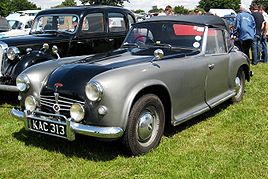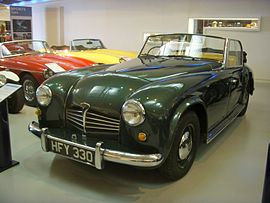- Marauder Cars
-
Marauder A and 100 Manufacturer Marauder Cars Production 1950–1952
15 made[1]Body style 2-door convertible
2-door coupéEngine Rover 2103 cc straight 6 (A model)
2392 cc (100 model)Transmission 4-speed manual with optional overdrive Wheelbase 102 in (2591 mm) Length 166 in (4216 mm) Curb weight 2,576 lb (1,168 kg) Designer George Mackie, Spencer King, Peter Wilks Marauder Cars was a British car company founded by Rover engineers George Mackie and Peter Wilks. Peter Wilks and George Mackie left the Rover Company in 1950 to form Wilks, Mackie and Company to exploit their idea of a two-seater sports car (the Marauder) based on the new Rover 75 chassis. Manufacturing started in Dorridge, West Midlands and later in Kenilworth, Warwickshire between 1950 and 1952. The two decided to change the name from Wilks, Mackie and Company to the Marauder Car Company in 1951.
The design was largely the work of Peter Wilks and "Spen" King who, like Wilks, was a nephew of brothers Spencer and Maurice Wilks who ran the Rover car company and was later famous for his involvement in many Rover and Leyland Group designs. The car named the "A", later joined by the "100", was based on the Rover P4 75 with the chassis shortened by 9 inches (230 mm) from 111 inches (2,800 mm) to 102 inches (2,600 mm), the track remaining the same at 52 inches (1,300 mm). The suspension was stiffened retaining the coil sprung independent front suspension and elliptical sprung live rear axle. The engine was moved back to allow for the fitting of 2/3-seater open coachwork with the Rover gearbox retained with optional overdrive instead of the Rover free wheel mechanism. The gearchange moved from column to floor. One fixed head coupé was also made. The first few bodies were made by Richard Mead in his Dorridge works and used some Rover panels but later ones were made by Abbey Panels of Coventry.[1] The 6-cylinder, inlet over exhaust valve, 2103 cc Rover engine was slightly modified with higher compression ratio to raise the output by 5 bhp (4 kW; 5 PS) to 80 bhp (60 kW; 81 PS) whilst the 100 version was bored out to 2392 cc and fitted with triple SU carburettors to give 105 bhp (78 kW; 106 PS). The "A" was capable of 90 mph (145 km/h) and the "100" 100 mph (161 km/h)
About 15 cars were made including 2 of the "100"s before rising costs and tax changes priced the cars out of the market. The UK government doubled the already high level of Purchase Tax (the UK version of Sales Tax) on cars with a pre-tax price above £1000.[2]. In 1950 the car cost £1236 rising to over £2000 in 1952.[1] Both George Mackie and Peter Wilks rejoined Rover.
References
External links
Categories:- Defunct motor vehicle manufacturers of the United Kingdom
- Sports cars
- Vehicles introduced in 1950
Wikimedia Foundation. 2010.


